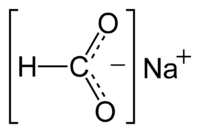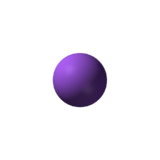Sodium formate
 | |||
| |||
| Names | |||
|---|---|---|---|
| Other names
formic acid, sodium salt, sodium hydrocarbon dioxide | |||
| Identifiers | |||
| 141-53-7 | |||
| ChEMBL | ChEMBL183491 | ||
| ChemSpider | 8517 | ||
| EC Number | 205-488-0 | ||
| Jmol interactive 3D | Image | ||
| PubChem | 2723810 | ||
| UNII | 387AD98770 | ||
| |||
| |||
| Properties | |||
| HCOONa | |||
| Molar mass | 68.007 g/mol | ||
| Appearance | white granules deliquescent | ||
| Density | 1.92 g/cm3 (20 °C) | ||
| Melting point | 253 °C (487 °F; 526 K) | ||
| Boiling point | decomposes | ||
| 43.82 g/100 mL (0 °C) 97.2 g/100 mL (20 °C) 160 g/100 mL (100 °C) | |||
| Solubility | insoluble in ether soluble in glycerol, alcohol, formic acid | ||
| Acidity (pKa) | 7.0-8.5 (0.1M) | ||
| Thermochemistry | |||
| 82.7 J/mol K | |||
| Std molar entropy (S |
103.8 J/mol K | ||
| Std enthalpy of formation (ΔfH |
-666.5 kJ/mol | ||
| Gibbs free energy (ΔfG˚) |
-599.9 kJ/mol | ||
| Hazards | |||
| EU classification (DSD) |
not listed | ||
| NFPA 704 | |||
| Except where otherwise noted, data are given for materials in their standard state (at 25 °C [77 °F], 100 kPa). | |||
| | |||
| Infobox references | |||
Sodium formate, HCOONa, is the sodium salt of formic acid, HCOOH. It usually appears as a white deliquescent powder.
Uses
Sodium formate is used in several fabric dyeing and printing processes. It is also used as a buffering agent for strong mineral acids to increase their pH, as a food additive (E237), and as a de-icing agent.
In structural biology, sodium formate can be used as a cryoprotectant for X-ray diffraction experiments on protein crystals,[1] which are typically conducted at a temperature of 100K to reduce the effects of radiation damage.
Preparation
Sodium formate can be prepared in the laboratory by neutralizing formic acid with sodium carbonate. It can also be obtained by reacting chloroform with an alcoholic solution of sodium hydroxide.
or by reacting sodium hydroxide with chloral hydrate.
- C2HCl3(OH)2 + NaOH → CHCl3 + HCOONa + H2O
The latter method is, in general, preferred to the former because the low aqueous solubility of CHCl3 makes it easier to separate out from the sodium formate solution, by fractional crystallization, than the soluble NaCl would be.
For commercial use, sodium formate is produced by absorbing carbon monoxide under pressure in solid sodium hydroxide at 160 °C.
Sodium formate may also be created via the haloform reaction between ethanol and sodium hypochlorite in the presence of a base. This procedure is well documented for the preparation of chloroform.
See also
References
- ↑ Bujacz, G.; Wrzesniewska, B.; Bujacz, A. (2010), "Cryoprotection properties of salts of organic acids: a case study for a tetragonal crystal of HEW lysozyme", Acta Crystallographica Section D: Biological Crystallography 66 (7), pp. 789–796, doi:10.1107/S0907444910015416
|


